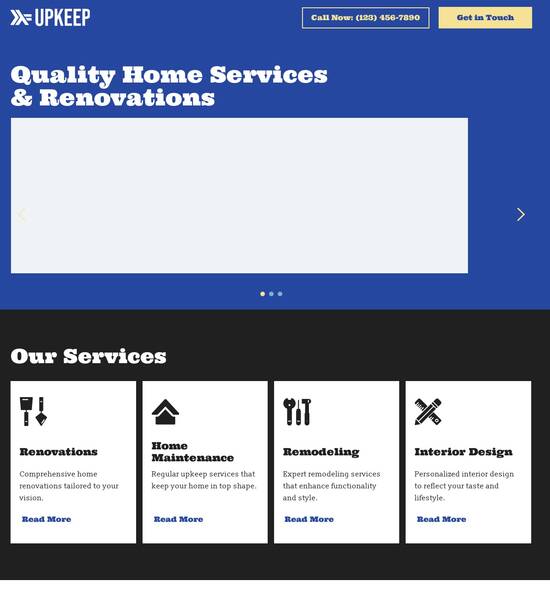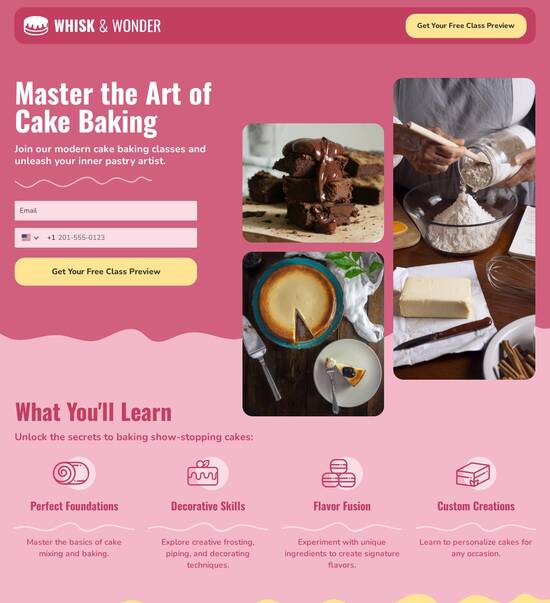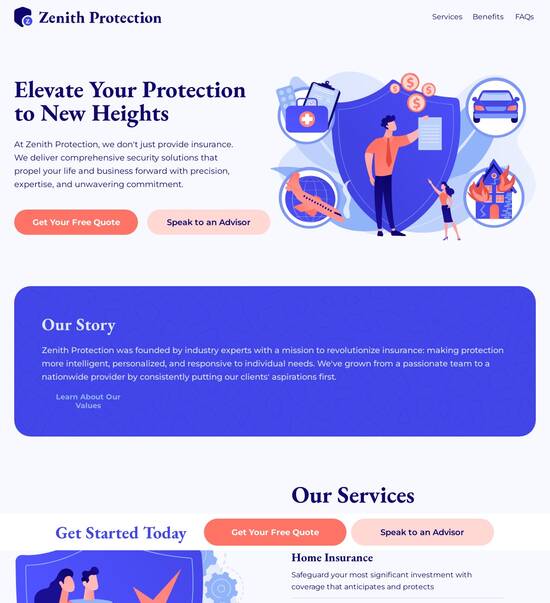
Microsite template for fast food restaurants
Explore Similar TemplatesAbout template
Jumpstart your microsite with our polished, ready-to-go template for fast food restaurants.
Recommended templates

Easy to build without coding
With the intuitive drag-and-drop builder, anyone on your team can create high-converting pages without any knowledge of code or design. Make enhancements to your landing page with custom widgets using Javascript, HTML/CSS, or third-party scripts.

Multiple layouts for any industry and goal
Select from 500+ landing page layouts built to boost conversions across industry-specific scenarios. Customize them by adjusting fonts, adding images, and generating on-brand content with the AI assistant. Quickly scale with Instablocks® and Global Blocks that you can save, reuse, and update globally.

Loads fast and looks polished on any device
Every template is responsive, which means they present professionally on any device and load blazingly fast with our Thor Render Engine. You can also power them up with Google AMP technology to deliver an unparalleled mobile experience and drive higher conversions.

Robust analytics & experimentation
Get real-time updates and reporting across all your devices, showing the number of visitors, conversions, cost-per-visitor, and cost-per-lead. Launch AI-powered experiments, run A/B tests, and use heatmaps to analyze user behavior, then optimize your landing page to maximize conversions.







Easy to build without coding
With the intuitive drag-and-drop builder, anyone on your team can create high-converting pages without any knowledge of code or design. Make enhancements to your landing page with custom widgets using Javascript, HTML/CSS, or third-party scripts.
Multiple layouts for any industry and goal
Select from 500+ landing page layouts built to boost conversions across industry-specific scenarios. Customize them by adjusting fonts, adding images, and generating on-brand content with the AI assistant. Quickly scale with Instablocks® and Global Blocks that you can save, reuse, and update globally.
Loads fast and looks polished on any device
Every template is responsive, which means they present professionally on any device and load blazingly fast with our Thor Render Engine.
Robust analytics & experimentation
Get real-time updates and reporting across all your devices, showing the number of visitors, conversions, cost-per-visitor, and cost-per-lead. Launch AI-powered experiments, run A/B tests, and use heatmaps to analyze user behavior, then optimize your landing page to maximize conversions.
All the features you need to build lead-generating landing pages
Explore more featuresLearn how to build top-performing landing pages for any goal
FAQs
Leading the way in building high-performing landing pages





A comprehensive guide to optimizing landing pages with Instapage
For marketers striving to accelerate their campaigns and maximize ROI, utilizing an effective landing page strategy is critical. Instapage's advanced tools are designed to help you craft high-converting pages tailored to your audience, transforming your marketing efforts into measurable success.
Understanding the importance of landing pages
Landing pages are crucial as they serve as the first point of interaction between a visitor and your brand. They are specifically designed with a single objective in mind, whether it be capturing leads, promoting a product, or driving user action. With Instapage, you can create these pages effortlessly, utilizing conversion-focused layouts and components.
- Capture leads effectively: With ready-to-use templates and lead generation elements, Instapage allows quick creation of forms to capture visitor information.
- Drive targeted traffic: Custom landing pages help direct traffic from ads or social media campaigns, ensuring that visitors are met with specific, relevant content.
- Increase conversions: By employing detailed analytics and A/B testing, you can continuously optimize your landing pages for improved performance.
Step 1: Choose your template
Instapage offers over 100 customizable landing page templates that cater to various industries. Selecting the appropriate template is vital for aligning with your campaign objectives and target audience.
Step 2: Personalize your content
Once the template is chosen, it’s important to customize your content to resonate with your audience. Here are some personalization tactics:
- Dynamic text replacement: Use this feature to customize headlines and phrases according to the unique attributes of your visitors.
- Segmentation: Align your ads to unique pages for different audience segments, ensuring that each visitor feels directly addressed.
- Visual elements: Incorporate imagery and videos that reflect your brand’s identity and promote engagement.
Step 3: Optimize and test
Before launching, leverage Instapage's optimization tools to test various elements of your landing page.
- A/B testing: Experiment with different headlines, calls-to-action, or images to determine what performs best.
- Heatmaps: Utilize heatmaps to analyze visitor behavior on your page, identifying areas that may require improvement.
- Analytics dashboards: Review your page’s performance metrics to assess conversions and engagement levels.
By following these steps, marketers can successfully harness the power of Instapage to build landing pages that convert.
Start crafting compelling landing pages today with Instapage. Whether you’re a small business or a large corporation, enhance your digital marketing efforts and achieve your ROI goals.
People also ask about Microsite template for fast food restaurants
Microsite template for fast food restaurants
Understanding the concept of microsites in fast food restaurants
Microsites have emerged as essential tools in digital marketing, especially for fast food restaurants looking to enhance their online presence. These small, focused websites serve specialized content tailored to specific marketing campaigns or promotions. Unlike standard websites comprising numerous pages and content, microsites are often single-page or include just a few pages that target particular customer goals.
The fast food industry benefits significantly from a specialized approach to marketing due to its competitive nature. A microsite can focus solely on specific products, seasonal promotions, or even campaigns tied to local events, allowing businesses to craft messages that resonate with their audience without the distractions of a comprehensive site. This tailored strategy fosters better engagement and ultimately drives sales.
Defining microsites: A niche necessity
Microsites differ fundamentally from traditional websites in their simplicity and specificity. Where traditional sites exhibit a broad range of content, microsites hone in on a singular goal, making them particularly useful for precise marketing efforts in the fast food space. Brands can quickly inform customers about new menu items, promote limited-time offers, or host contests without cluttering their main website.
In fast food marketing, a specialized approach is essential due to the rapidly changing consumer preferences and market trends. This requires restaurants to pivot and respond quickly with engaging, relevant content that keeps their audience hooked. Microsites offer an effective solution, enabling faster deployment of marketing strategies and tailored messages that are sure to catch the eye.
The role of templates in streamlining microsite development
Microsite templates play a crucial role in simplifying the development process for fast food brands. A microsite template is essentially a pre-designed framework that facilitates the creation of a microsite with minimal effort. These templates come equipped with various features optimized for user experience, ensuring that businesses can launch effective marketing campaigns without the need for extensive web development resources.
Speed: Templates allow for rapid development, enabling fast food restaurants to get their promotions online quickly.
User-Friendly: Most templates are crafted with drag-and-drop functionalities, making them accessible even for non-technical users.
Customization: Templates provide room for branding while maintaining a structure that can effectively showcase unique offerings.
Using templates rather than custom-built sites offers numerous advantages, including cost savings and time efficiency. For fast food chains, this means they can focus more on strategy and less on complex coding, ensuring that marketing efforts are timely and impactful.
Key features of a fast food microsite template
When selecting a microsite template for fast food restaurants, several key features should be prioritized to ensure maximum effectiveness. One essential characteristic is responsive design, which allows the microsite to adjust seamlessly across various devices and screen sizes. With a large portion of consumers searching for food on mobile devices, having an adaptable layout is paramount.
Templates should also offer pre-designed menu options, allowing easy showcasing of food items. Features that enable interactivity, like hover effects or sliders to display specials, can significantly enhance user engagement. Finally, customizable branding elements such as colors, fonts, and logos are important to maintain a consistent brand identity.
Responsive design: A mobile-first approach
In the fast food sector, mobile optimization is not just important; it's an absolute necessity. Customers often search for quick dining options while on the go, making a responsive design critical for these microsites. A mobile-first approach means the site is built to function optimally on mobile devices before adapting to desktop formats, ensuring that users accessing the site from smartphones have a seamless browsing experience.
Effective mobile layouts focus on quick navigation, making it easy for users to view menus, locate store hours, and engage with promotional content. Examples of successful mobile layouts incorporate drop-down menus and large, tappable buttons. Creating an engaging interface fosters a positive user experience, encouraging potential customers to make quick dining decisions.
Pre-designed menu options: Showcase your offerings
Displaying the menu is one of the critical features of a fast food microsite template. Fast food restaurants thrive on quick decision-making from customers, and having an attractive, interactive menu right on the microsite can facilitate this. Pre-designed menu options should allow for easy updates so that restaurant owners can include new promotions, seasonal items, or limited-time offers without hassle.
Interactive Menus: These enable customers to explore different meal options and combinations seamlessly.
Easy-to-Update Features: Restaurant owners can quickly change menu items or prices as needed, reflecting real-time availability.
High-Quality Visuals: Images are key to appetizing representation and should be provided in the template for better engagement.
Overall, a well-structured menu display within the template layout is vital for driving customer interest and facilitating swift online orders.
Customizable branding elements: Create a unique identity
Brand consistency is vital in the fast food industry. A microsite template should offer customizable branding elements so that restaurants can maintain their unique identities across digital platforms. This customization should include options for adjusting colors, fonts, and logos, ensuring that their branding aligns perfectly with their overall marketing strategy.
Integrating brand storytelling through design elements is also significant. For instance, using background images that represent the restaurant's theme or ethos can evoke emotions and engage users more effectively. Addressing your audience's key values—such as sustainability or community focus—through compelling visuals can help fast food brands build an emotional connection.
Integration capabilities: Connect your ecosystem
Successful fast food marketing campaigns often leverage various digital platforms including social media, apps, and email marketing tools. Therefore, a good microsite template should include integration features that connect these platforms seamlessly. This connectivity is essential for amplifying audience reach and engagement.
Social Media Links: Enable easy sharing and following capabilities to encourage customer interaction.
Email Collection Features: Gather customer emails for newsletter sign-ups and promotional alerts.
Cross-Promotion Opportunities: Link to apps or other digital platforms to enhance the customer journey.
Successful integration creates an ecosystem that fosters customer loyalty through multiple touchpoints, ensuring that fast food restaurants can keep their audience engaged across various channels.
The practical benefits of using a microsite template
The benefits of utilizing a microsite template for fast food marketing extend beyond just aesthetic choices; they also offer practical advantages. Firstly, speed to market is paramount for promoting seasonal offerings, limited-time deals, and new menu launches. Templates reduce development time, enabling restaurants to deploy campaigns quicker than if they were building from scratch.
In the fast-paced world of fast food, timely marketing campaigns can significantly impact sales. Real-life examples illustrate how fast food chains have used quick-launch templates to promote new items, enhancing customer engagement and driving sales with minimal lag time.
SEO optimizations: Increasing online discoverability
Optimizing a microsite for search engines is essential for attracting foot traffic to fast food restaurants. A great microsite template incorporates SEO-friendly features such as customizable meta tags and alt texts for images. These elements enhance discoverability on search engines, driving more organic traffic to the site.
Additionally, local SEO is particularly critical for fast food chains, as many customers rely on location-based searches. Templates that focus on local keywords and Google My Business integration can significantly improve foot traffic to restaurants. By following best practices in content optimization, fast food businesses can effectively build online visibility.
User engagement tools: Building customer relationships
Introducing user engagement tools within microsite templates enhances customer relationships. Features like feedback forms, interactive quizzes, and chatbots allow fast food brands to foster a sense of connection with their audience. These tools not only improve the user experience but also provide valuable insights into customer preferences and behaviors.
Feedback Forms: Allow customers to share their experiences and suggestions directly.
Chatbots: Provide instant assistance, helping customers navigate the menu or place orders.
Engagement Techniques: Incorporating rewards programs can encourage repeat business, incentivizing customers to return.
Enhancing user experience through intuitive layouts can lead to consistent repeat business, establishing long-term customer loyalty.
How to effectively customize your fast food microsite
Customizing a microsite to reflect a fast food restaurant's unique essence is vital. Fortunately, many templates come equipped with tools that allow non-coders to make adjustments effortlessly. User-friendly site builders often include drag-and-drop functionalities, enabling marketers to develop engaging sites without requiring programming skills.
Choose Your Template Wisely: Select a template that offers the right layout and features for your objectives.
Utilize Pre-Designed Elements: Take advantage of existing structures and focus on differentiating aspects of branding.
Incorporate User Feedback: Use insights from customer interactions to fine-tune your site.
By leveraging templates effectively, fast food restaurants can save time and infuse their unique flair into the microsite, enhancing overall market appeal.
A/B testing features: Fine-tuning for success
A/B testing is a powerful tool for optimizing the effectiveness of marketing campaigns. Incorporating built-in A/B testing features into microsite templates allows fast food marketers to experiment with different versions of their content, layouts, and calls-to-action to identify the most successful strategies.
For example, a fast food chain might test two different menu layouts or promotional banners to see which captures more attention and results in higher engagement. By analyzing the data collected during these tests, restaurants can make informed decisions that enhance overall marketing effectiveness.
Tracking & analytics: Measuring your success
No marketing effort is complete without a robust tracking and analytics system. Micro sites should integrate features that enable fast food restaurants to measure customer interactions, such as page visits, dwell time, and engagement rates. This data-driven approach fosters insights that can refine future strategies.
By interpreting analytical data effectively, fast food brands can identify which promotions resonate with customers and which tactics might need adjustments. Making informed decisions based on analytics leads to improved marketing efforts and enhances overall restaurant performance in a competitive landscape.
Conclusion: The future of fast food marketing with microsites
The potential for growth through innovative microsite practices is substantial for fast food brands. Adopting specialized templates can streamline marketing processes and ensure engagement remains high in an ever-evolving digital landscape. As consumer preferences continue to shift, maintaining a fresh, relevant online presence becomes critical.
Fast food companies are encouraged to leverage microsite templates as a means for modern marketing strategies, adapting quickly while providing valuable customer experiences. By staying ahead of trends and effectively utilizing digital tools, these brands can solidify their positions in a competitive industry.
Ready to skyrocket conversions?
Supercharge your ad campaigns with high-performing landing pages
Get started














